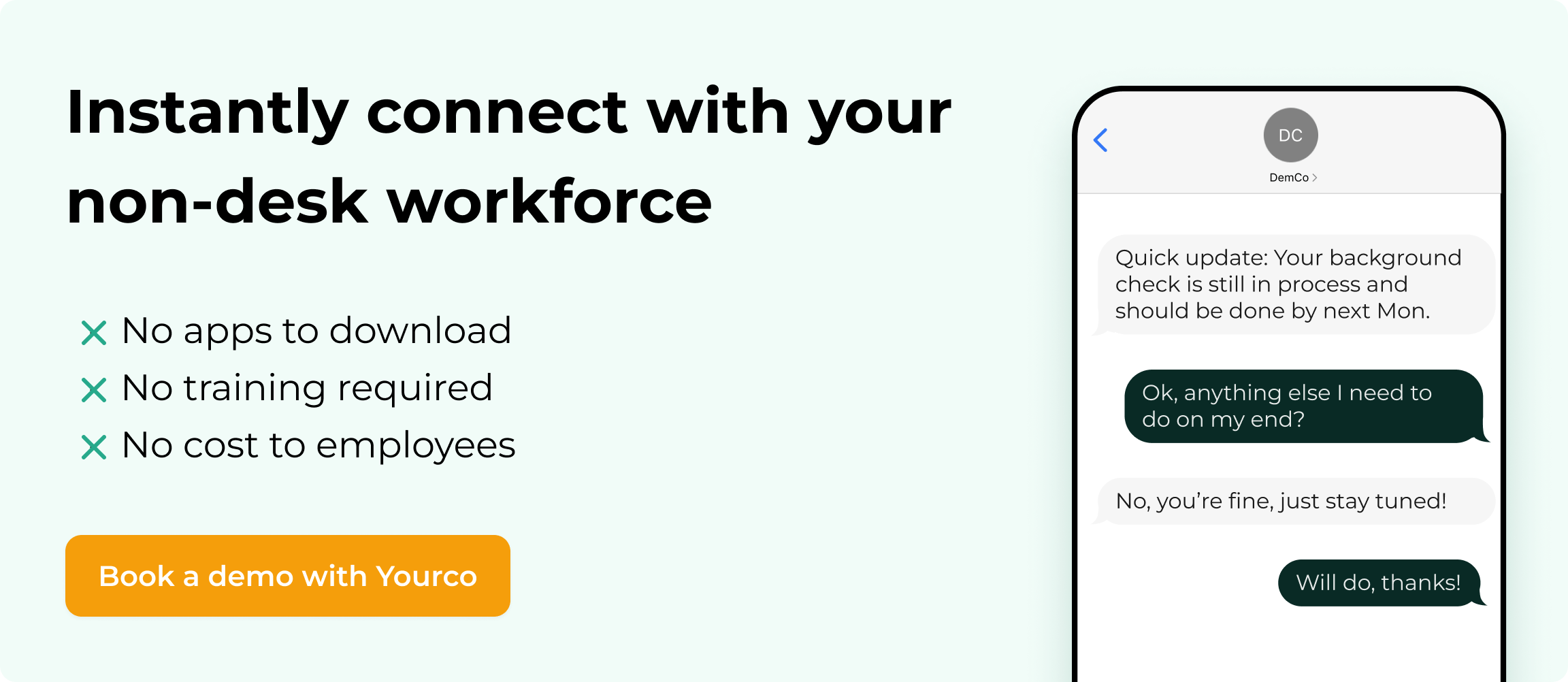What Is a Prioritization Framework and How to Build One?


Missed shift alerts, clashing safety updates, and any schedule conflicts can throw an entire operation off balance. When every minute counts, you need a clear system to decide which message deserves immediate attention and which can wait. That's exactly what a prioritization framework gives you.
By using a structured approach, whether it's a simple Impact-Effort grid or a categorical MoSCoW list, you replace gut feelings with clear criteria. This cuts decision fatigue and helps teams respond faster when it matters.
This guide will show you what prioritization frameworks are, why teams need them and how to build one that turns chaos into order.
What Is a Prioritization Framework?
A prioritization framework is simply a clear way to decide what to tackle first. Instead of endless debates over each request, you apply consistent rules that quickly identify which tasks need immediate attention.
These frameworks use structured methods to score or categorize work, ranking tasks based on objective criteria rather than hunches. Common approaches include RICE scoring, value-versus-effort matrices, and urgency-impact grids. Each method turns unclear priorities into clear rankings you can explain to anyone on your team.
Product managers use these tools to handle backlogs filled with competing features. The same approach works for any team with limited people, equipment, or budget. Clear criteria reduce bias, speed up decisions, and keep everyone focused on what truly matters.
Field crews face even higher stakes, as they rarely have time for lengthy discussions or detailed email chains. A simple matrix posted in the break room or a quick scoring system shared via text helps sort last-minute shift changes, safety alerts, and maintenance tasks on the spot. For example, when everything passes through the same filter, the crew understands why a broken lift gate takes priority over routine inventory.
These frameworks protect your most valuable resources. When you match urgency and impact against actual effort required, you avoid wasting time on low-value work, make better decisions, and focus energy where it keeps operations running smoothly.
How Prioritization Frameworks Improve Communication
In any organization, messages move fast, but not always clearly. Whether you’re in HR, operations, or compliance, it’s easy for important updates to get buried under less urgent chatter. Without a clear system for sorting information, teams struggle to focus on what truly matters. That’s where prioritization frameworks come in.
These systems help you assign urgency and importance to every communication. They create a shared language across departments, making it easier for teams to understand what needs immediate attention, what can wait, and what’s optional.
For example, without a framework, you might send out a data security alert and a reminder about a team lunch with the same emphasis. But when every message is categorized by priority, recipients instantly know where to focus.
The impact is broad:
- Employees act faster on critical updates because the signal is clear.
- Managers avoid bottlenecks by aligning teams on what's urgent versus routine.
- Leaders reduce overload by delegating or deferring tasks with lower value.
This kind of system becomes especially powerful for frontline teams, who often work without constant email access and rely on quick-read formats like SMS or push notifications. In those environments, a prioritization framework doesn’t just streamline communication, but it can also prevent mistakes and save time.
From office teams managing compliance deadlines to field crews responding to safety alerts, prioritization frameworks turn scattered communication into a focused, trusted system. They improve how information flows, how quickly teams respond, and how confidently decisions get made.
4 Simple Prioritization Frameworks for Better Decision-Making
Whether you're managing a production floor or coordinating a marketing launch, competing tasks can pile up fast. Prioritization frameworks give teams a structured way to sort what matters now from what can wait, without needing advanced tools or drawn-out meetings.
Here are four practical models that work across departments from operations and HR to customer support and field services.
1. Value vs. Effort Matrix
This model weighs task usefulness against how much work it takes. Picture a simple grid: value rises on one side, effort runs along the bottom. Placing tasks on this grid gives you an instant visual of what needs action now and what can wait.
Once you’ve plotted tasks on the Value vs. Effort grid, the next step is deciding what to do and when. Here’s how to read the results:
- High-value, low-effort tasks, such as updating safety operating procedures or fixing a broken link on your website, jump to the top of your list.
- High-value, high-effort tasks, such as migrating a CRM or replacing a conveyor belt, should wait for adequate time and staff.
- Low-value, low-effort items, such as updating team bios or repainting faded lines can fill quiet periods.
- Low-value, high-effort tasks, such as building a tool nobody uses can usually be dropped.
This grid can live on a whiteboard in the office, a shared doc, or a quick photo sent via text. Everyone gets a clear view of priorities, without needing to chase clarification.
2. Eisenhower Matrix (Urgent vs. Important)
Some problems need attention right away. Others just feel urgent. This framework helps your team separate true emergencies by asking two questions: Is it urgent? Is it important?
Once you’ve asked those two questions, you can sort tasks into four clear categories:
- Urgent and important tasks, such as a payroll error or a leaking forklift, get immediate attention.
- Important but not urgent tasks, such as onboarding updates or safety training, should be scheduled.
- Urgent but less important tasks, such as duplicate deliveries, can often be delegated.
- Anything neither urgent nor important, such as reworking last month’s slide deck for no real reason, can be dropped.
This model works perfectly for daily planning across roles — from desk-based IT ticket triage to morning shift huddles on a job site. When everyone uses the same terms ( urgent, important, scheduled, dropped), assignments become clearer and responses faster.
3. RICE Lite (Reach, Impact, Effort)
Originally built for product teams, RICE is also helpful in prioritizing internal projects, process improvements, or tech updates. This simplified version examines how many people the task affects (reach), how much it improves outcomes (impact), how sure you are about its impact (confidence), and how much work it requires (effort).
Say you're choosing between launching a new emergency alert system or updating a weekly inspection checklist. The alert system reaches every team member and could prevent incidents, but requires more setup. The checklist update helps fewer people with smaller payoff.
To decide which task takes priority, break it down using three simple steps:
- Rate each factor from 1 to 10
- Multiply reach by impact
- Divide by effort
Higher scores get priority. This method takes under a minute during a site walk and points you in the right direction.
4. MoSCoW Method (Must, Should, Could, Won't)
When juggling dozens of tasks with limited hands, the MosCow method sorts everything with four clear labels (‘’Must’’, ‘’Should’’, ‘’Could’’, and ‘’Won’t’’):
- "Must" tasks are non-negotiable, such as fixing a compliance issue or addressing known safety risks.
- "Should" items, such as refining internal reports or repainting safety lines, matter but can wait days.
- "Could" includes helpful but non-essential tasks such as updating team photos or reorganizing inventory.
- "Won't" means the task stays off this shift's agenda, and that's fine.
Use this model during sprint planning, shift prep, or cross-functional standups. Labeling tasks this way avoids debates and helps everyone align on what really matters.
How to Build a Prioritization Framework for Your Team
A custom framework keeps everyone aligned and turns gut decisions into consistent routines. Follow these six steps to create a system your crew can use during any shift.
1. Gather Everyday Tasks, Alerts, and Headaches
Start with an unfiltered list of what fills your day: equipment checks, safety reminders, customer callbacks, paperwork — everything. Ask supervisors and workers what trips them up or steals time. Use a whiteboard, text thread, or quick walk-around survey. Focus on capturing patterns, not one-time emergencies.
2. Choose a Model that Matches Your Pace
Look at common frameworks and select one that feels natural for your team. If you need quick decisions, a Value-vs-Effort matrix sketches easily on a clipboard. For bigger projects, MoSCoW's "Must, Should, Could, Won't" categories provide clearer boundaries. Pick the simplest option your team will actually use.
3. Define Clear, Easy-to-Understand Criteria
Write down what "high impact," "urgent," or "easy" mean for your operation. Keep the criteria focused and limited for quick scoring. For office-based teams, consider:
- Revenue impact: Does this directly influence sales or retention?
- Cross-team dependency: Is another team waiting on this to move forward?
- Time sensitivity: Will delaying this task affect a deadline, compliance rule, or public launch?
For field crews, this might include:
- Safety risk (will someone get hurt if we wait?)
- Customer reach (how many people affected?)
- Effort (crew hours or parts needed)
Having clearly defined scoring points lets everyone, from shift leads to department heads, make faster decisions without back-and-forth approvals. And when priorities are challenged, you’ve got a neutral, documented system to fall back on.
4. Score or Tag Every Item
Run your list through your chosen framework. With RICE, give each task a rough score for how many people it affects (Reach), how much it helps (Impact), and how confident you are it’ll work (Confidence). Multiply those together, then divide by how much effort it takes (Effort). The higher the number, the higher the priority.
If you’re using MoSCoW, just label each task as a Must, Should, Could, or Won’t. You can write it on a sticky note, whiteboard, or in your team chat. Don’t worry about being perfect, since quick and consistent is more important than precise numbers.
5. Share the Results in Plain View
For field teams, that might mean a break-room whiteboard, a laminated sheet in work trucks, or a paper handout at the morning huddle. For desk-based teams, it could be the first slide in a daily standup deck, a shared project board in tools like Asana or Trello, or a pinned message in Slack.
The goal is the same: make priorities visible and easy to reference throughout the day. Welcome questions so your logic stays transparent. When teams understand why one task jumps the line, whether it’s a critical bug fix or a safety repair, resistance drops and alignment improves.
6. Review At Least Once A Week
Priorities change quickly. A new compliance rule might show up, a client request could shift the roadmap, or equipment may suddenly break down. To keep your prioritization system useful, review it regularly. For field teams, this might be a five-minute check during shift handover. For desk-based teams, a quick review during a weekly standup or planning session works well.
If something changes midweek, like a delayed shipment, a sudden outage, or a new leadership directive, update the list and adjust as needed. These short reviews help your team stay aligned without starting from scratch each time.
This simple routine keeps the framework active and visible. It reduces second-guessing and helps everyone stay focused on the tasks that matter most.
What Tools Can Help Put Your Framework into Practice?
The right employee notification system turns a paper system into a living process you can update instantly. When choosing a tool, look for four basics:
- Mobile-friendly alerts: So that changes reach everyone fast
- Clear visual boards: To spot priorities at a glance
- Simple tags or scores: To rank tasks
- Read-receipts: To confirm messages landed
Many employee communication apps deliver parts of this solution. Collaborative tools guide teams through workshops and capture votes in real time. Road-mapping software calculates scores automatically and connects your list to a schedule. Project dashboards can show heat-maps revealing where effort exceeds value.
For field teams, though, even the best dashboard fails if nobody sees it. Workers on job sites, in warehouses, or on delivery routes need simpler solutions. That's why Yourco keeps it basic as a text message. You can push an "urgent" alert to every phone on shift, pin today's priorities, run a quick survey for input, and see who's read or replied. No downloads needed.
Yourco logs every action, giving you data to refine your scoring. You'll see which priority levels get fastest responses and which messages teams ignore. This helps adjust your framework based on actual behavior, not guesswork.
Signs Your Prioritization System Is Working
You'll notice benefits quickly, but tracking specific metrics helps prove impact and refine your approach. Watch for signs showing whether the right tasks get attention and reach completion. Monitor these key indicators:
- Fewer missed shifts or unfinished tasks
- Declining safety incidents after critical updates reach teams promptly
- Faster response to urgent issues
- Higher completion rates for "must-do" items compared to last month
- Positive feedback during daily check-ins or pulse surveys
If these signals start trending in the right direction, it means your framework is working where it counts.
Take 15 minutes monthly to review these numbers with your team lead. Pair data with a short, two-question feedback form: "Did our priorities feel clear?" and "What slowed us down?" When trends stall or answers turn negative, adjust your scoring weights or tighten criteria before the next cycle.
Put Prioritization to Work with Yourco
Clear frameworks help you focus on what matters and reduce decision fatigue. When your crew knows exactly what needs attention first, shift changes run smoother, safety updates reach people on time, and resources go where they make the biggest difference.
Start small. Pick one framework from this guide and try it with a single alert type or during your busiest shift. Once you see how much clearer things become, expand it to other sites or departments. Building consistency creates confidence and momentum.
Yourco makes this rollout simple. You can tag an SMS with "Must" or "Quick Win," and it will appear at the top of every worker's phone. Schedule lower-priority reminders for later, send a quick text poll to check impact, and see who's read each message in real time.
With Yourco, you spend less time chasing confirmations and more time guiding your team forward. Everyone gets messages in a format that works for them, whether they're tech-savvy or not. Ready to see how it works? Try Yourco for free today or schedule a demo and experience the difference the right workplace communication solution can make.
Frequently Asked Questions
How often should we review our prioritization framework?
Review your framework every three months to keep it aligned with changing business goals and team capacity. Systems like RICE or MoSCoW work better when you refresh your assumptions about reach, impact, and priorities.
If your team handles daily work orders or manages fast-moving crews, check in more often. Run a quick review after every major shift cycle. You can add these discussions to existing routines, like weekly team huddles or monthly safety checks. This keeps the process familiar while catching new challenges early.
Can we use multiple prioritization frameworks simultaneously?
Yes, but start simple. Some teams use an Impact-Effort matrix to quickly filter their task list, then apply weighted scoring to their top candidates. This approach gives you precision, but it can confuse supervisors who just want clear direction.
Advice: Pick one approach first. Test it for a few cycles and see how well your team understands it. Only add a second framework if you have a specific gap to fill, like balancing customer needs against technical risks.
How do we handle urgent "skip the queue" items?
First, check if the request truly qualifies as urgent. Safety issues and regulatory deadlines count. "Nice-to-have" requests don't. Next, run the urgent item through a fast version of your framework. Many teams use the Eisenhower Matrix for this: urgent plus important equals "do now."
Communicate your decision right away so everyone knows why a task jumped ahead. Document it for your next full review. This keeps the process transparent and prevents false emergencies from undermining your system.
What's the ideal number of criteria for a prioritization framework?
Stick to three to five criteria. Fewer than three oversimplifies important trade-offs. More than five turns every decision into a lengthy debate. Team leaders typically combine impact, effort, and risk, then add one or two specific factors like safety or customer reach.
Keeping criteria limited helps frontline managers apply the framework quickly. It also makes it easier for crew members to understand why work gets ordered the way it does. If you need more variables, consider combining related factors like cost and effort into one score.
Who should own the prioritization process in cross-functional organizations?
One person needs to be accountable, even when multiple people provide input. In operations, this might be an area supervisor or program lead. The owner facilitates scoring sessions, maintains the task list, and shares final rankings.
To keep other teams engaged, invite representatives from safety, HR, or IT to score items that affect their area. Make it clear that the designated owner has final tie-breaking authority. This setup prevents back-channel negotiations and speeds up decisions.
How can we measure the impact of our prioritization framework after implementation?
Capture a baseline before you start. Track missed shifts, completed work orders per week, incident reports, or whatever metrics your framework aims to improve. Then measure the same things for at least one review cycle, ideally 30 to 90 days.
Tools likeAha! make it easy to compare throughput, cycle time, and team feedback scores. Better numbers mean higher-value work is getting done faster. Flat or declining results suggest your criteria need adjustment. Review these findings with your team, tweak weights or categories as needed, and repeat. Regular measurement turns your framework from a static document into a practical decision tool that works for everyone on your team.



